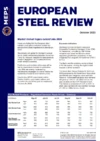Plate prices correct downwards after war-induced surge
Fears about feedstock shortages in the European hot rolled plate market following Russia’s invasion of Ukraine have eased considerably in recent months.
European steel manufacturers have successfully switched the sources of their slab deliveries from CIS countries. Asian and Brazilian producers now supply the vast majority of their requirements. This has largely dispelled any supply-side concerns.
Many plate rerollers, who were temporarily absent from the market, have resumed quoting. Consequently, mill delivery lead times are shortening. Buyers across the continent report that plate material is now readily available.
Ahead of the seasonally slow summer period, the majority of continental stockholders are scaling down their purchasing requirements and keeping their inventories to a minimum.
Prices, for hot rolled plate, are tumbling fast. This is because of a considerable change in market fundamentals. Figures in Western Europe fell by between €220 and €370 per tonne, in July, relative to the June values.
In late February, the breakout of war in Ukraine was the catalyst for a skyrocketing of plate values across the continent. Prices doubled, in a short period of time, due to a shortage of slab.
Plate manufacturers, in Europe, were hugely reliant on imported feedstock, from both Ukraine and Russia. Ukrainian slab suppliers were forced to cease trading, owing to the military action. Deliveries from Russia also came to a halt. This was due to sanctions being imposed by the European authorities.
Plate producers hiked their selling prices, amid the uncertainty surrounding feedstock. Ex-mill prices approached, or in certain cases breached, the €2000 per tonne threshold.
Current figures are between €1050 and €1100 per tonne in southern Europe. Values are higher in the north and west of the region.
Despite the scale of the decline, this month, there is considerable doubt whether European hot rolled plate prices will fall significantly further, in the near term. Many market participants believe that they could be nearing the bottom.
Plate producers may be unwilling to make additional price concessions. It is unlikely that they will be prepared to sell material below the cost of production, given the escalating outlay on energy.
The summer period also presents European mills with the opportunity to take extended outages for planned maintenance. Regional supply is expected to tighten, as a result.
Manufacturers also have grounds for optimism, from a demand perspective.
End-user plate consumption is decent. Activity levels in energy-related projects, particularly windmills, are healthy. The plate market has benefited from significant funding from the European Union in the post-pandemic period. This is expected to continue, in the medium-to-long term, despite inflated material expenditure, and the increased cost of borrowing in many countries.

Source:
European Steel Review
The MEPS European Steel Review is an informative, concise and easy-to-use monthly publication, offering unique professional insight into European carbon steel prices.
Go to productRequest a free publication





